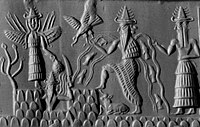| Abzu | |
|---|---|
| Genealogy | |
| Consort | Tiamat |
| Children | Kingu (Babylonian religion), Lahamu, Lahmu, Anu (Sumerian religion) |
| Part of a series on |
| Ancient Mesopotamian religion |
|---|
 |
|
|
| Primordial beings |
Seven gods who decree
|
| Other major deities |
Minor deities
|
Demigods and heroes
|
| Spirits and monsters |
| Tales |
| Terms |
The Abzû or Apsû (Sumerian: 𒀊𒍪 abzû; Akkadian: 𒀊𒍪 apsû), also called E ngar (Cuneiform:𒇉, LAGAB×HAL; Sumerian: engar; Akkadian: engurru – lit. ab = 'water' zû = 'deep', recorded in Greek as Ἀπασών Apasṓn), is the name for fresh water from underground aquifers which was given a religious fertilising quality in ancient near eastern cosmology, including Sumerian and Akkadian mythology. It was believed that all lakes, springs, rivers, fountains, rain, and even the Flood, as described in Atrahasis, originated from the Abzû. In Mesopotamian cosmogony, it is referred to as the freshwater primordial ocean below and above the earth; indeed the Earth itself was regarded as a goddess Ninhursag that was conceived from the mating of male Abzu with female saltwater ocean Tiamat. Thus the divine Mother Earth – on her surface equipped with a bubble of breathable air – was surrounded by Abzû, and her interior harbours the realm of the dead (Irkalla).
In Sumerian culture
In the city of Eridu, Enki's temple was known as E2-abzû (house of the deep waters) and was located at the edge of a swamp – an abzû. Certain tanks of holy water in Babylonian and Assyrian temple courtyards were also called abzû (apsû). Typical in religious washing, these tanks were similar to Judaism's mikvot, the washing pools of Islamic mosques, or the baptismal font in Christian churches.
In Sumerian cosmology
The Sumerian god Enki (Ea in the Akkadian language) was believed to have keen eyes and appeared out of the abzû since before human beings were created. His wife Damgalnuna, his mother Nammu, his advisor Isimud and a variety of subservient creatures, such as the gatekeeper Lahmu, also lived in the abzû.
As a deity

Abzû (apsû) is depicted as a deity only in the Babylonian creation epic, the Enūma Eliš, taken from the library of Assurbanipal (c. 630 BCE) but which is about 500 years older. In this story, he was a primal being made of fresh water and a lover to another primal deity, Tiamat, a creature of salt water. The Enūma Eliš begins:
- "When above the heavens (e-nu-ma e-liš) did not yet exist
- nor the earth below,
- Apsû the freshwater ocean was there, the first, the begetter,
- and Tiamat, the saltwater sea, she who bore them all;
- they were still mixing their waters,
- and no pasture land had yet been formed,
- nor even a reed marsh."
The act of procreation led to the birth of the younger gods: Enki, Enlil, and Anu. Anchored in the Tablet of Destinies, they founded an organisation to make Mesopotamia fertile through agriculture, but got into a dispute and consequently created the first humans as labour slaves, to peacefully resolve the conflict. The humans multiplied en masse and disturbed the gods around Enlil and Anu with their noise, so that they wanted to use the cosmic freshwater ocean to trigger the great flood and destroy the humans (cf. Athrahasis epic). Enraged by the devastation of earth, Tiamat gave birth to monsters whose bodies she filled with "poison instead of blood" and waged war against her traitorous children. Only Marduk, the founder of Babylon, was able to kill Tiamat and mould the final constitution of heaven and earth from her corpse.
In popular culture
Abzû is a 2016 adventure game that was influenced by Sumerian mythology of Abzû.
See also
- Abyzou – Name of a female demon
- Cosmic ocean – Mythological motif
- Firmament – Solid dome dividing the primal waters
- Nu – Ancient Egyptian personification of the primordial watery abyss
- Varuna – Hindu deity associated with water
- Wuji – The primordial in Chinese philosophy
Notes
- Maul, Stefan (October 2006). "Apsȗ". In Gentry, Francis G. (ed.). Brill's New Pauly (English ed.). Brill. doi:10.1163/1574-9347_bnp_e129820. ISBN 9789004122598.
- Green, Margaret Whitney (1975). Eridu in Sumerian Literature (Ph.D. thesis). Chicago, IL: University of Chicago. pp. 180–182.
- Black, Jeremy; Green, Anthony (1992). "abzu, apsû". Gods, Demons, and Symbols of Ancient Mesopotamia: An illustrated dictionary. University of Texas Press. ISBN 0-292-70794-0.
- Orlin, Eric (19 November 2015). "Abzu". Routledge Encyclopedia of Ancient Mediterranean Religions. Routledge. p. 8. ISBN 978-1134625529. Retrieved 7 November 2024 – via Google books.
- Horowitz, Wayne (1998). Mesopotamian Cosmic Geography. Eisenbrauns. p. 308. ISBN 0931464994 – via Google books.
- Putthoff, Tyson (2020). Gods and Humans in the Ancient Near East. Cambridge University Press. p. 71. ISBN 978-1108490542 – via Google books.
- Eppihimer, Melissa (2019). Exemplars of Kingship: Art, tradition, and the legacy of the Akkadians. Oxford University Press. p. 188. ISBN 978-0190903015.
- Pope, Charles N. (2016). "Part I: Early Pharaohs". Living in Truth: Archaeology and the patriarchs. DomainOfMan.com. p. 17.
- Jordan, Michael (1993). Encyclopedia of Gods: Over 2,500 deities of the world. New York, NY: Facts on File. p. 2. ISBN 9780816029099 – via Internet Archive.
- Haske, Steve (27 September 2016). "Exploring the hidden depths of Abzû". Inverse. Nava, Matt (Abzû creative director). Archived from the original on 9 March 2017. Retrieved 22 April 2017.
External links
- [REDACTED] Quotations related to Abzu at Wikiquote
| Sumerian mythology | ||
|---|---|---|
| Primordial beings |  | |
| Primary deities | ||
| Other major deities | ||
| Minor deities | ||
| Demons, spirits, and monsters | ||
| Mortal heroes | ||